Photo
album: "Kathmandu"
Fly
over a photo with the mouse to enlarge it
Click
on a photo to open it in a new window
We
arrive in Calcutta (India), in the evening, on Thursday April 18th, 1968. The
following day we go to the Nepal embassy to solicit a visa (it was not possible
to obtain it in Australia). On Saturday April 20th, in possession of the visa,
we have our air travel tickets modified in: Calcutta, Kathmandu, Pokhara,
Kathmandu, New Delhi, Paris. We will not use the segment Calcutta - Kathmandu.
We buy a train ticket, third-class wooden couchettes, to go to Banaras. Trains
in India are faster and more comfortable than in Malaysia or in Thailand and,
spreading our sleeping bags over the couchettes, we can rest a little… In
Banaras we buy another train ticket to Raxaul, on the Nepalese frontier. While
we are queuing up, for three hours, to book couchettes again, we catch sight of
a man we already saw at the YMCA* in Singapore. At the Raxaul customs office we
see him again and we have the opportunity to talk. We discover he is a Frenchman
and his name is Yves Gervais. We proceed in bus our journey to Kathmandu, where
we meet Yves again and we can speak a little more and know him better. He his 53
and has been travelling for 14 years. He stops to work for a while when he has
no money left, then he resumes travelling, taking a lot of photos. As for me, I
didn't take a single photo in Calcutta, there was too much misery in the streets,
even dead people on the pavement in the morning..
(*) YMCA : Hotel of the Young Men Christian Association. We find them mainly in
Anglo-Saxon countries like Australia and also in the Asian principal cities.
They offer beds at moderate prices and we lodged in them in Hobart, Sydney,
Singapore, Bangkok, Calcutta and New Delhi. It exists also hotels of the YWCA
for the women, but I don't know if they are as numerous as the ones for men.
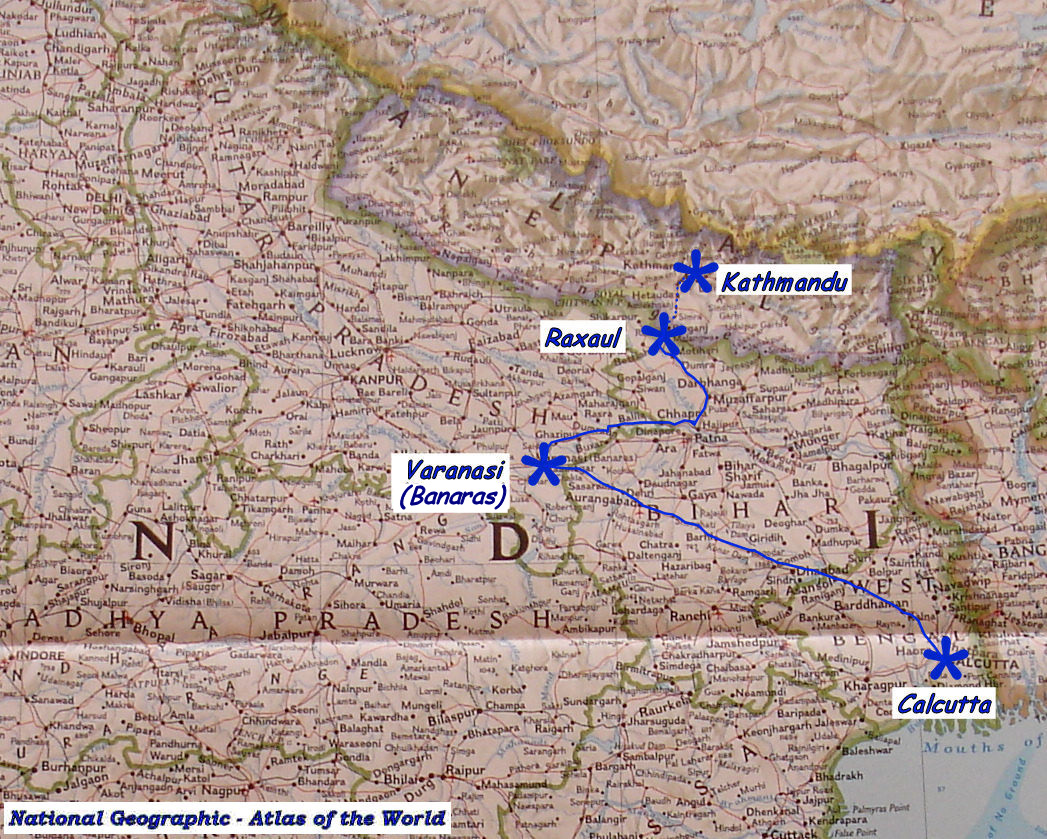 |
We leave Calcutta, in train, on
April 20th, late evening. We arrive in Banaras (Varanasi for the Indians)
the next day, end of the morning. We leave Banaras, in the evening, on
April 22nd. We have to change train twice, first in Muzaffarpur and then
in Sagauli. We arrive at last in Raxaul, on April 23rd, end of the
afternoon. After passing the Nepalese frontier, early in the morning, on
April 24th, we continue in bus towards Kathmandu where we arrive, end of
the afternoon. |
 |
Banaras, one of the seven sacred
cities of Hinduism, also venerated by the Buddhists. We are on the bank of
Ganges river. Every morning at sunrise, Hindu pilgrims go down one of
these "ghats" (large stairways) to make their own ablutions in
the sacred waters of the river. On top of some of these ghats corpses are
being cremated and their ashes are, then, scattered over Ganges' waters.
It is the way every Hindu would like to end after his death. |
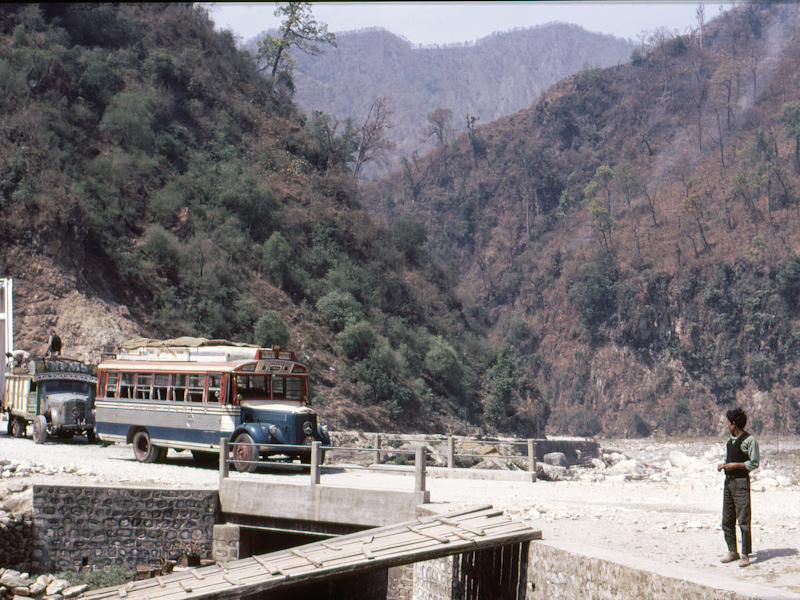 |
The bus that transports us from the
Nepalese frontier, in front of Raxaul (India), up to Kathmandu. We left at
7:00 in the morning. We followed a stream bed and, a few times, the road
having disappeared under a landslide, the bus had to proceed unto the
pebbles of the torrent bed and to ford the stream itself from time to
time. Fortunately the stream was shallow enough. We stop for lunch around
10:30 a.m.. Then a long steep road with many sharp bends allows us, around
1:00 p.m., to reach the pass, more than 2000-metre high. Then, after a not
less fearful descent, we arrive into the Kathmandu valley. We stop finally,
around 5:00 p.m., in the Nepalese capital. |
 |
A market place in Kathmandu… We
met Yves again. We are in the same hotel. We will spend several evenings
speaking for hours with him… André and me deposited a request for a
"trekking permit" to go from Pokhara to Jomosom and for a 15-day
visa extension to give us time enough to do the trek. |
 |
A merchant in Kathmandu… Here too
we rent bicycles, but only when we have to go out of the town. However we
would not try to leave Kathmandu valley because we do not feel courageous
enough to tackle the climbs, especially with these old bicycles… I could
buy, in a shop, two more Kodachrome II films, thus I nearly offset the
theft of Chiang Mai. We also bought "jungle boots", the only
shoes we found that seemed to fit well enough our needs for the trek. Up
to now we have been wearing thongs* like a lot of people in the different
countries we visited.
(*) Thongs: see the last photo of this page |
 |
A rather scaring scaffolding in
bamboo. We understand there are different safety rules here than in our
countries. It is not that bamboo is not a very strong material, but there
is absolutely nothing to prevent the workers to fall down. |
 |
A few kilometres from Kathmandu, on top of a hill, we visit Swayambunath
Stupa. It is one of the oldest Buddhist temples. We reach there after
climbing a more than 300-step stairway. On the top of the stairway, a big
Vajra (on the right of the photo) protects the ingress of the temple. The
faithful step clockwise around the stupa making the prayer-mills rotate (some
of those mills can be seen under a narrow red roof, at the centre of the
photo). There are also a few small temples where the faithful have incense
sticks burning and where they deposit food offerings (rice, fruit, etc.)
that are eaten by the several monkeys dwelling in the temple.
|
 |
At the centre of the temple, rises
the stupa where are kept the relics, it consists in a white dome topped by
a gilded tower with the Buddha's eyes staring in the four directions:
North, East, South and West. The figure looking like an interrogation mark
in the middle under each pair of eyes is the number "1" in
Devanagari*. It symbolises the unity and the unique path to reach
illumination, following the teaching of the Buddha.
(*) Devanagari: alphabet of several languages of ancient and modern
India, like Sanskrit, Hindi and Nepali. |
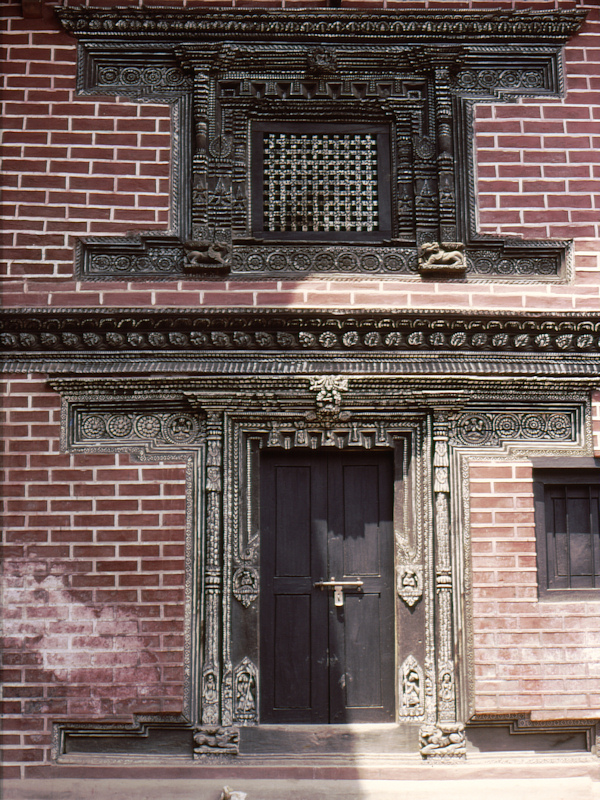 |
On bicycles, Yves, André and I
went to the neighbour town of Patan. The several temples are generally
made of bricks and carved wood, as on the photo. There are also many small
shops selling jewels, small boxes and other handicraft in metal inlaid
with semi-precious stones. |
 |
At Durbar Square, where many
temples are, in the courtyard of Mul Chowk temple (former Royal Palace),
in Patan. |
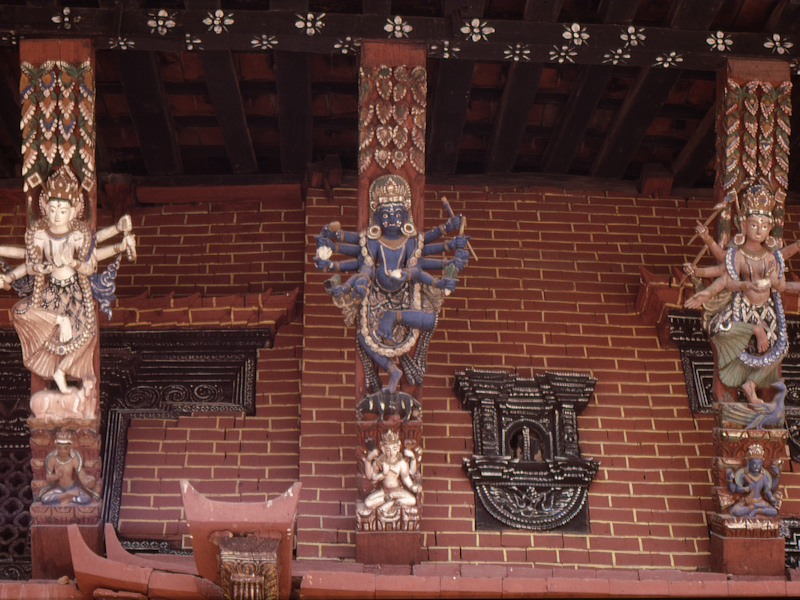 |
Carvings of Hindu divinities below the roof of Mul Chowk temple, in Patan.
|
 |
Two little girls and their mother
in a street of Patan. |
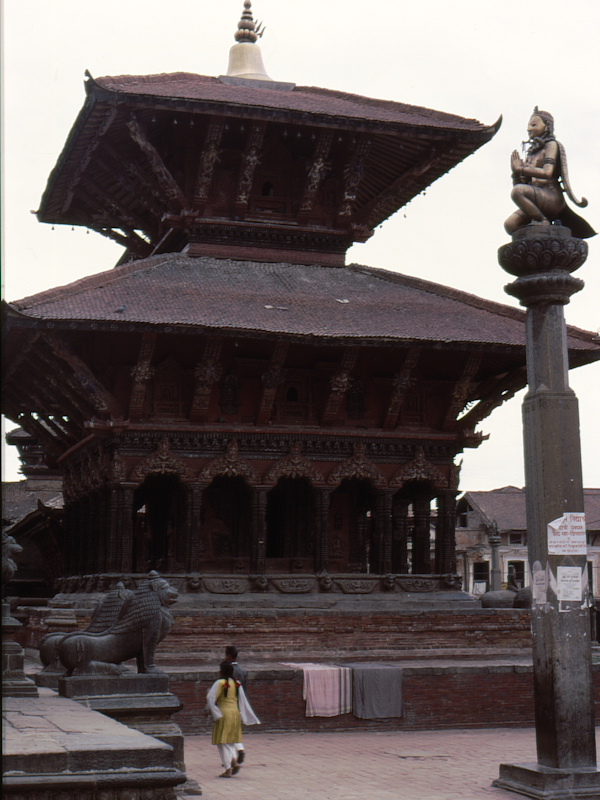 |
On top of the column, Garuda's
statue, in front of one of the temples of Durbar Square, in Patan. |
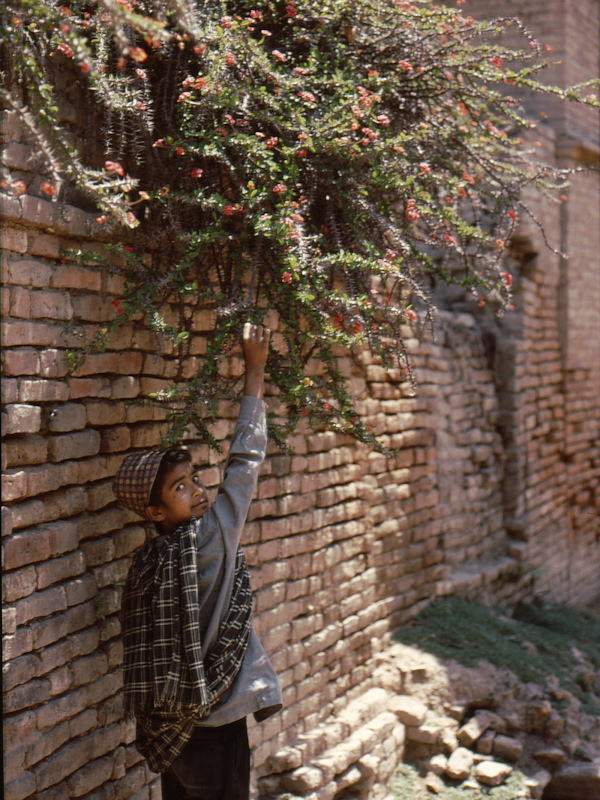 |
Always on bicycle, we went to visit
the other important town of the Kathmandu valley: Bhadgaon (Bhaktapur). On
the photo, a young boy who proposed to guide us for a few paisa (hundredths
of a rupee). |
 |
A street in Bhadgaon. We see a man
transporting goods. He uses a stick put upon his shoulder. At each end of
the stick hangs a basket containing the things to be carried… Instead,
in the mountains, Nepalese people carry heavy loads on their back, the
load is hold in position by a strap leaning on their forehead. Once,
during the trek, we saw a sick man, on a chair, being transported in that
manner. |
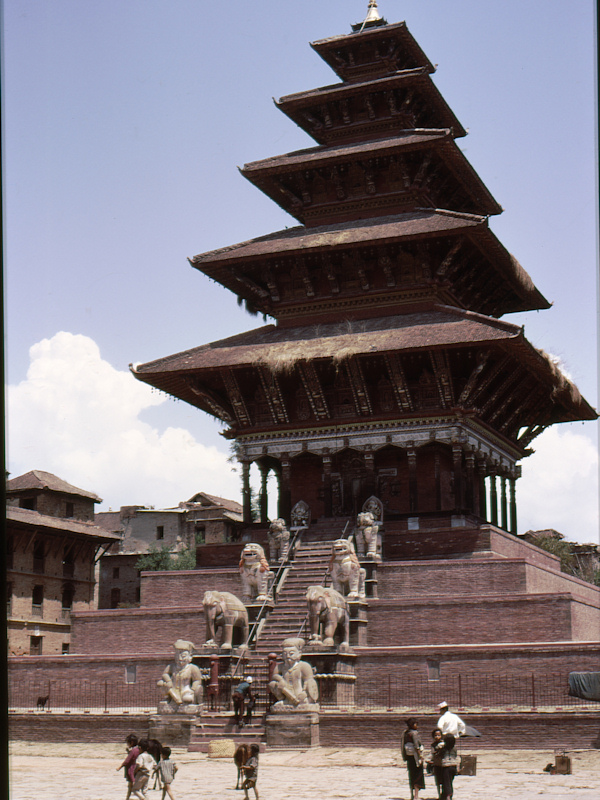 |
Nyatapol temple, in Bhadgaon… We
went back to Bhadgaon with Yves, in bus, early morning another day. This
town is the starting point of the path climbing to Nagarkot (altitude 2300
m). We hope to have a look, from there, at the mountains which are much of
the time hidden under the clouds. |
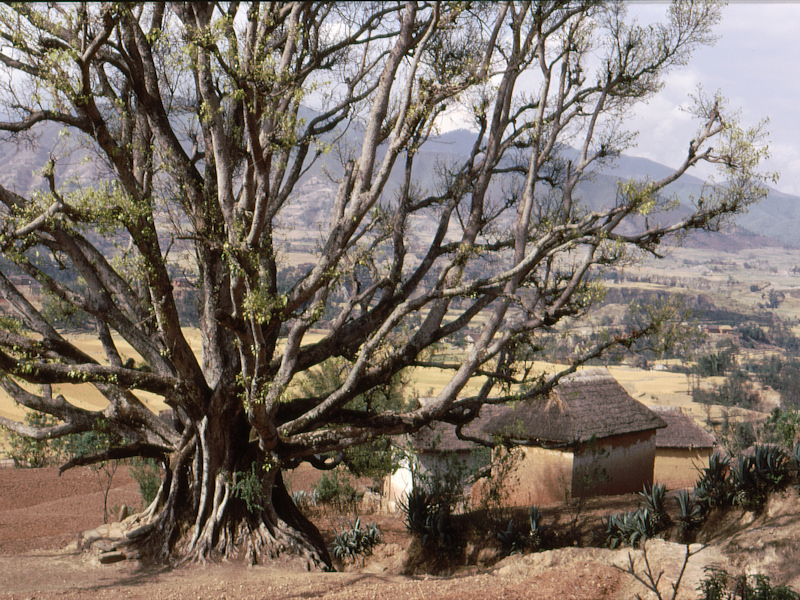 |
A beautiful tree, along the path
leading to Nagarkot. |
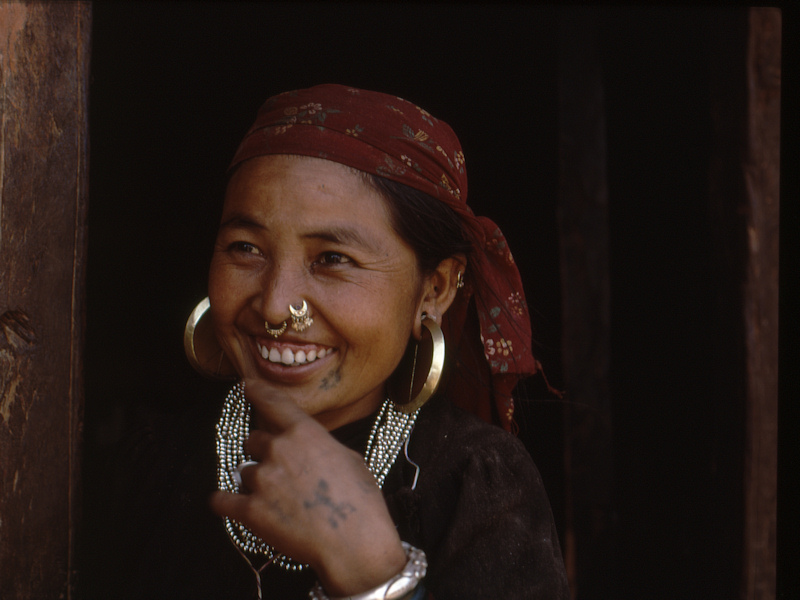 |
A Nepalese woman on the threshold
of her house, along the path of Nagarkot. We asked, in "sign language",
the permission to take a picture of her. Afterwards we gave her a few
coins to thank her. |
 |
Fields on terraces along the path. We climbed at a higher altitude then we
walked down to the little village of Nagarkot where we arrived around noon
and where we could find beds in a small hotel's dormitory. It rained in
the afternoon and the mountains remained hidden by the clouds.
|
 |
The next morning we got up at 5
o'clock, hoping for an opening which let us see the high summits of the
Himalaya. For a few minutes we could catch sight of a small piece of the
mountain range but the clouds came back. We will wait for
our approaching trek to see them better and nearer, even if they won't be
the same summits… Back to Kathmandu, we understand that our shoes are
not so well suited for long walks since they gave our feet several
blisters. Blisters that will give us a lot of troubles during our trek
because they will get infected. |
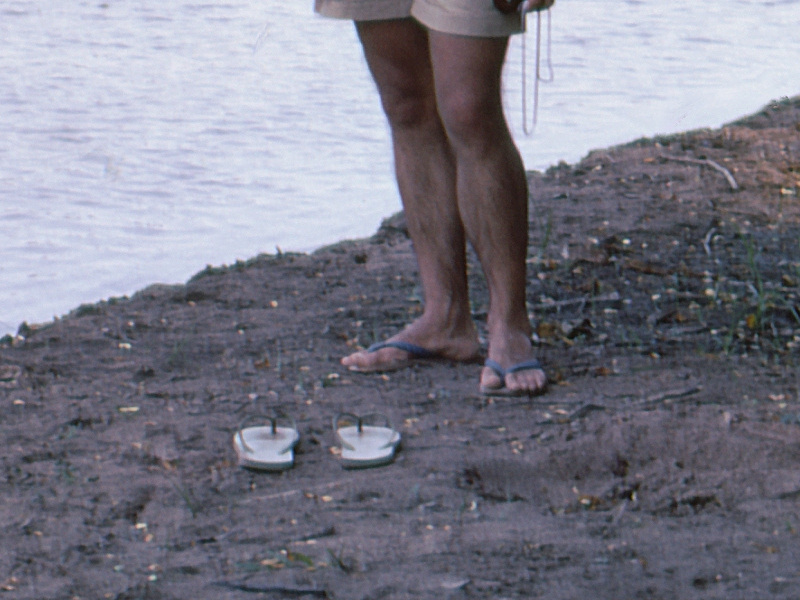 |
About shoes: This has been our
weak point, instead we should have prepared it carefully in order to do
our trek in the best conditions. We should have bought good quality shoes,
suited to long walks in mountain, when we were in Australia and we should
have worn them from time to time to get used to them and don't arrive in
Nepal with never-used shoes. On the contrary, we remained with thongs in
our feet the last two months (see photo), that is nearly bare-footed, and
we bought in Kathmandu "jungle boots" made mainly of rubber
which didn't let our feet breathe. Walking in thongs, after Nagarkot, in
the dirty streets of Kathmandu made our injuries getting infected and the
difficulty to find, on the spot, effectual remedies to cure these injuries
didn't help us. |
Go
back
.
.
.
.
.
.
.







